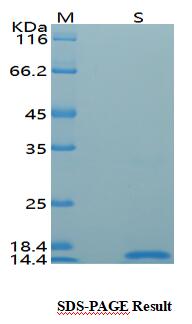Product Name :
CD337 Recombinant Protein Swiss-Prot :
O14931 Host :
E.coli Tag :
≥0.5mg/ml Amino acid Sequence :
LWVSQPPEIRTLEGSSAFLPCSFNASQGRLAIGSVTWFRDEVVPGKEVRNGTPEFRGRLAPLASSRFLHDHQAELHIRDVRGHDASIYVCRVEVLGLGVGTGNGTRLVVEKEHPQLG Restriction sites :
NdeI-XhoI Background :
The immune response is the way the body recognizes and defends itself against microorganisms, viruses and substances recognized as foreign and potentially harmful to the body. Innate immunity is the barrier that keeps foreign materials from entering the body and represents the first line of defense in the immune response. During the innate response to many inflammatory and infectious stimuli, dendritic cells (DCs) undergo a differentiation process termed maturation. Mature DCs activate antigen-specific naive T cells and resting human natural killer (NK) cells. NK cell receptors NKp30, NKp44 and NKp46 appear to play prominent roles in NK cell activation. The human NKp30 gene maps to chromosome 6p21.3 and encodes a 190 amino acid protein. The NKp30 protein contains a signal peptide followed by a 120 amino acid extracellular region that forms a V-type Ig-like domain with 2 potential N-linked glycosylation sites, a hydrophobic transmembrane region with a positively charged Arginine residue, and a 33 amino acid cytoplasmic tail lacking an immunoreceptor tyrosine-based activating motif (ITAM). NKp30 cooperates with NKp46 and/or NKp44 in the induction of NK-mediated cytotoxicity against the majority of target cells, where it represents the major triggering receptor in the killing of certain tumors. Soluble :
PBS, 4M Urea, PH7.4 Purification&Purity :
Transferred into competent cells and the supernatant was purified by NI column affinity chromatography and the purity is > 85% (by SDS-PAGE). Storage&Stability :
Store at 4°C short term. Aliquot and store at -20°C long term. Avoid freeze-thaw cycles. Expression vector :
pet-22b(+) BiowMW :
~13kDa Note :
For research use only, not for use in diagnostic procedure. concentration :
≥0.5mg/ml
CD337 Recombinant Protein Swiss-Prot :
O14931 Host :
E.coli Tag :
≥0.5mg/ml Amino acid Sequence :
LWVSQPPEIRTLEGSSAFLPCSFNASQGRLAIGSVTWFRDEVVPGKEVRNGTPEFRGRLAPLASSRFLHDHQAELHIRDVRGHDASIYVCRVEVLGLGVGTGNGTRLVVEKEHPQLG Restriction sites :
NdeI-XhoI Background :
The immune response is the way the body recognizes and defends itself against microorganisms, viruses and substances recognized as foreign and potentially harmful to the body. Innate immunity is the barrier that keeps foreign materials from entering the body and represents the first line of defense in the immune response. During the innate response to many inflammatory and infectious stimuli, dendritic cells (DCs) undergo a differentiation process termed maturation. Mature DCs activate antigen-specific naive T cells and resting human natural killer (NK) cells. NK cell receptors NKp30, NKp44 and NKp46 appear to play prominent roles in NK cell activation. The human NKp30 gene maps to chromosome 6p21.3 and encodes a 190 amino acid protein. The NKp30 protein contains a signal peptide followed by a 120 amino acid extracellular region that forms a V-type Ig-like domain with 2 potential N-linked glycosylation sites, a hydrophobic transmembrane region with a positively charged Arginine residue, and a 33 amino acid cytoplasmic tail lacking an immunoreceptor tyrosine-based activating motif (ITAM). NKp30 cooperates with NKp46 and/or NKp44 in the induction of NK-mediated cytotoxicity against the majority of target cells, where it represents the major triggering receptor in the killing of certain tumors. Soluble :
PBS, 4M Urea, PH7.4 Purification&Purity :
Transferred into competent cells and the supernatant was purified by NI column affinity chromatography and the purity is > 85% (by SDS-PAGE). Storage&Stability :
Store at 4°C short term. Aliquot and store at -20°C long term. Avoid freeze-thaw cycles. Expression vector :
pet-22b(+) BiowMW :
~13kDa Note :
For research use only, not for use in diagnostic procedure. concentration :
≥0.5mg/ml
Blocking peptide available as NCP0297P

 CD337 Recombinant Protein
CD337 Recombinant Protein 
 Datasheet
Datasheet COA
COA MSDS
MSDS SHIP
SHIP